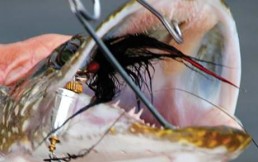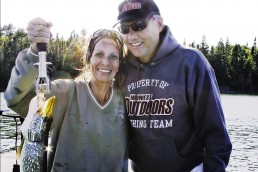Canadian Cabbage-bed Pike
The list of reasons why anglers are drawn to fish in the Canadian provinces are many including trophy-size potential, incredible numbers of fish, the scenic beauty and the allure of the North Country that harks back to simpler times. No matter how many trips I take into Canada—even after 25 years of adventures into Ontario, Manitoba and Saskatchewan—it always strikes me how quickly “true” remoteness appears. It may be driving down a winding Canadian highway and suddenly realizing a vehicle hasn’t passed you from the other direction for miles, the view from a floatplane with the expanse of timber dotted with waterways shimmering in the sunshine or the stillness and the silence on a lake that’s absent of any other human.
Canadian fishing experiences are legendary, and every angler should experience catching 100 walleyes a day or catching and releasing dozens of big, beautiful smallmouths. Perhaps the pursuit is more your game, followed by the wonderful thrill of triggering a thunderous strike from a trophy muskie or battling a goliath laker, a brilliantly-colored trout or arctic char or even angling a delicate grayling.
It’s hard to beat the consistent action delivered by a hot bite for northern pike. A plentiful species on many lakes, this fish is one of the easiest to trick on artificial lures, and a main reason to plan fishing trips to Canada. For my money, the best action for pike is during the late summer when the cabbage beds are in full bloom and the big “gators” are lying in the weeds. By the height of summer, water temperatures in shallow water rise above a big pike’s preferred comfort zone—mid 60s—and push them into deeper water in the lake basin below the thermocline where it’s hard to fish them with consistent success. By contrast, shallow pike are easier to catch. Find their lairs where these big ones hide; the cabbage beds usually are the key.
Green weeds produce dissolved oxygen at levels high enough to allow larger pike to tolerate water temperatures in the mid-70s, and for longer periods of time. These higher water temperatures speed up the metabolism of a large northern to help digest large high-protein forage. Depending on the lake system, the primary forage for trophy pike are suckers, whitefish or ciscoes, small lake trout, adult perch or walleyes. Big pike even eat fuzz-ball hatchings of various waterfowl species paddling about in the backwaters. Compared to the diet of minnows and insects that smaller predator species eat, these “large bites” preferred by pike take time to digest.
By early July, most northerns have transitioned out of the shallower back bays and establishing themselves throughout the deeper shorelines and points on a main-lake basin. Pike will suspend in the deep basin below the thermocline—especially on huge Canadian lakes—and subsist entirely on trout and whitefish for the summer. These fish may or may not gravitate to the cabbage beds from time to time, but many marine biologists speculate that some segments of the adult pike population reside exclusively in the deep basins all summer while others migrate back and forth to shallower water where they’re drawn to the cabbage beds. Weed beds in bays or along shorelines in close proximity to the deep basin are ideal spots to find them.
Cabbage pike lay in the weeds mostly inactive, suspended in 2 to 4 feet while drifting slowly throughout the cover. Stable, sunny weather makes the fish more active as their long tapered bodies warm in the glow of the sun, speeding up their metabolism. As cold fronts and storms approach, the fish go on a feeding binge. After a front, they’ll drop to the lake bottom and lay in a negative state at the base of the cabbage beds—no amount of casting may get these fish to rise up and hit a sub-surface crankbait, topwater lure, slow-falling soft plastic or inline bucktail that’s burned across the tops of the weeds. These lures, however, all are ideal choices to catch northerns holding high in the water columns within cabbage beds.
Think “small and slow,” in terms of lure selection for cabbage-bed pike. Large lures need to be powered on the retrieve. These often dive too deeply to be fished effectively in any heavy cover, unless you want it coming back to the boat with treble hooks full of greenery. Good lure choices include Vibrax inline spinners in sizes 4, 5 or 6 (choose the single-hook options rather than tandem spinners with two trebles), topwater lures with an evasive, “walk-the-dog” action like Storm’s new Top Walker (11 or 13), the 12-14 Rapala Husky Jerks or a variety of soft plastics like Berkley Jerk Shads and other fluke- or paddle-tail-style baits. Even a popular bass lure like a 6- to 10-inch stickworm will trigger strikes as it slow-falls through the weeds. Texas-rig all soft plastics to protect the hook point from snagging weeds. Fish lures like jerkbaits only in sparse cover and when you can keep a visual on a lure to help steer it through the weeds. The key is quiet entry to the water on the cast, the ability to control a lure with a slow retrieve and the shallow action. Only inline spinners necessitate a steady retrieve in order to keep a lure from hooking cabbage stalks. And use a good pair of polarized sunglasses, as these will help you steer the lure free of weeds on the retrieve in the sun.
Check out MidWest Outdoors Television for some exciting cabbage-bed pike fishing action filmed at Showalter’s Fly-ins last August. Owner and operator Eddie Showalter and I enjoyed incredible action for some quality Ontario northerns while fishing a large cabbage bed on a fly-on outpost lake. We captured some explosive action on topwater lures and landed numbers of fish on spoons and inline spinners.
That’s the beauty of fishing in Canada—lots of action, lots of big fish and lots of lifetime memories. Now is the right time to be researching destinations, reviewing websites, contacting lodge owners to check availabilities, asking questions and setting up vacations. Finalize your itineraries this month. A summer of fun fishing in Canada awaits you.
MWO
SHARE THIS POST
Did you enjoy this post?
You can be among the first to get the latest info on where to go, what to use and how to use it!


